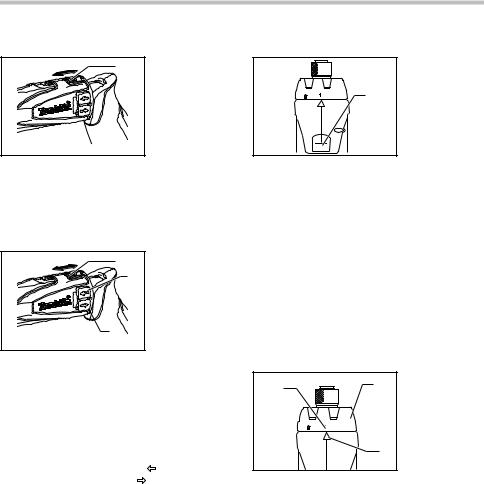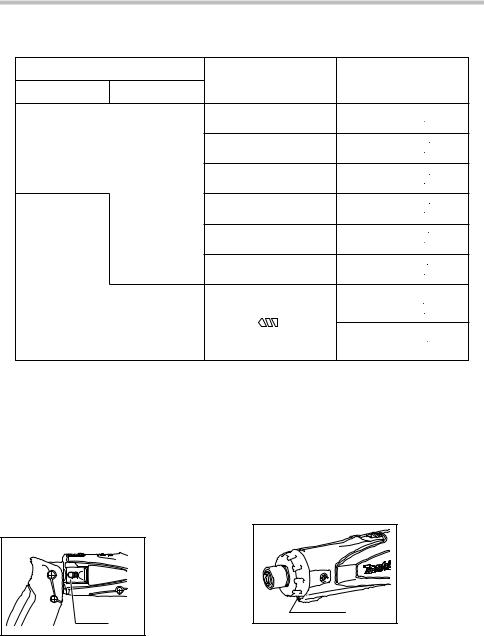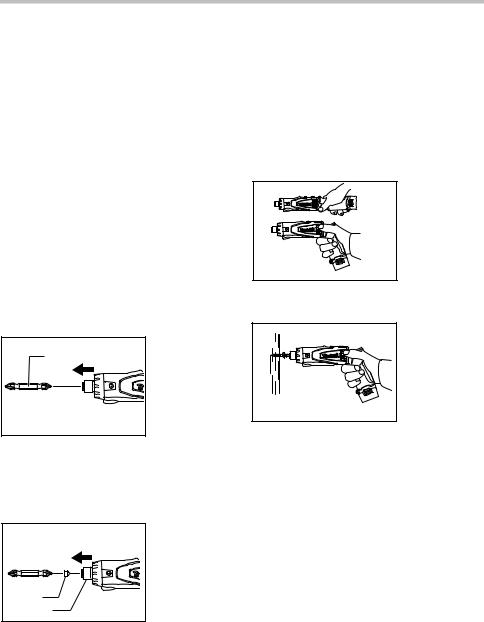Makita DF010D User Manual

INSTRUCTION MANUAL MANUEL D'INSTRUCTION
MANUAL DE INSTRUCCIONES
In-line Cordless Driver Drill Visseuse-perceuse sans fil rectiligne Destornillador-taladro en serie a batería
DF010D
008706
 WARNING:
WARNING:
For your personal safety, READ and UNDERSTAND before using. SAVE THESE INSTRUCTIONS FOR FUTURE REFERENCE.
 AVERTISSEMENT:
AVERTISSEMENT:
Pour votre propre sécurité, prière de lire attentivement avant l'utilisation. GARDER CES INSTRUCTIONS POUR RÉFÉRENCE ULTÉRIEURE.
 ADVERTENCIA:
ADVERTENCIA:
Para su seguridad personal, LEA DETENIDAMENTE este manual antes de usar la herramienta.
GUARDE ESTAS INSTRUCCIONES PARA FUTURA REFERENCIA.

ENGLISH
SPECIFICATIONS
Model |
|
DF010D |
|
|
|
Steel |
5 mm (1/5") |
Capacities |
|
Wood |
6 mm (1/4") |
|
Wood screw |
ø3.8 mm x 45 mm (5/32" x 1-3/4") |
|
|
|
||
|
|
Machine screw |
M5 (3/16") |
No load speed (RPM) |
|
High (2) |
650/min. |
|
Low (1) |
200/min. |
|
|
|
||
Overall length |
|
Straight type |
279 mm (11") |
|
Pistol type |
224 mm (8-7/8") |
|
|
|
||
Net weight |
|
0.55 kg (1.21lbs) |
|
Rated voltage |
|
D.C. 7.2 V |
|
Standard battery cartridge |
BL7010 |
||
•Due to our continuing programme of research and development, the specifications herein are subject to change without notice.
•Note: Specifications may differ from country to country.
GEA002-3
GENERAL SAFETY RULES
WARNING! Read all instructions. Failure to follow all instructions listed below may result in electric shock, fire and/or serious injury. The term "power tool" in all of the warnings listed below refers to your mains-operated (corded) power tool or battery-operated (cordless) power tool.
SAVE THESE INSTRUCTIONS.
Work area safety
1.Keep work area clean and well lit. Cluttered and dark areas invite accidents.
2.Do not operate power tools in explosive atmospheres, such as in the presence of flammable liquids, gases or dust. Power tools create sparks which may ignite the dust or fumes.
3.Keep children and bystanders away while operating a power tool. Distractions can cause
you to lose control.
Electrical Safety
4.Power tool plugs must match the outlet. Never modify the plug in any way. Do not use any adapter plugs with earthed (grounded) power tools. Unmodified plugs and matching outlets will reduce risk of electric shock.
5.Avoid body contact with earthed or grounded surfaces such as pipes, radiators, ranges and refrigerators. There is an increased risk of electric shock if your body is earthed or grounded.
6.Do not expose power tools to rain or wet conditions. Water entering a power tool will increase the risk of electric shock.
7.Do not abuse the cord. Never use the cord for carrying, pulling or unplugging the power tool.
Keep cord away from heat, oil, sharp edges or moving parts. Damaged or entangled cords increase the risk of electric shock.
8.When operating a power tool outdoors, use an extension cord suitable for outdoor use. Use of a cord suitable for outdoor use reduces the risk of electric shock.
Personal Safety
9.Stay alert, watch what you are doing and use common sense when operating a power tool. Do not use a power tool while you are tired or under the influence of drugs, alcohol or medication. A moment of inattention while operating power tools may result in serious personal injury.
10.Use safety equipment. Always wear eye protection. Safety equipment such as dust mask, non-skid safety shoes, hard hat, or hearing protection used for appropriate conditions will reduce personal injuries.
11.Avoid accidental starting. Ensure the switch is in the off-position before plugging in. Carrying power tools with your finger on the switch or plugging in power tools that have the switch on invites accidents.
12.Remove any adjusting key or wrench before turning the power tool on. A wrench or a key left attached to a rotating part of the power tool may result in personal injury.
13.Do not overreach. Keep proper footing and balance at all times. This enables better control of the power tool in unexpected situations.
14.Dress properly. Do not wear loose clothing or jewellery. Keep your hair, clothing, and gloves away from moving parts. Loose clothes, jewellery or long hair can be caught in moving
2

parts.
15.If devices are provided for the connection of dust extraction and collection facilities,
ensure these are connected and properly used.
Use of these devices can reduce dust-related hazards.
Power tool use and care
16.Do not force the power tool. Use the correct power tool for your application. The correct power tool will do the job better and safer at the rate for which it was designed.
17.Do not use the power tool if the switch does not turn it on and off. Any power tool that cannot be controlled with the switch is dangerous and must be repaired.
18.Disconnect the plug from the power source and/or the battery pack from the power tool before making any adjustments, changing accessories, or storing power tools. Such preventive safety measures reduce the risk of starting the power tool accidentally.
19.Store idle power tools out of the reach of children and do not allow persons unfamiliar with the power tool or these instructions to operate the power tool. Power tools are dangerous in the hands of untrained users.
20.Maintain power tools. Check for misalignment or binding of moving parts, breakage of parts and any other condition that may affect the power tools operation. If damaged, have the power tool repaired before use. Many accidents are caused by poorly maintained power tools.
21.Keep cutting tools sharp and clean. Properly maintained cutting tools with sharp cutting edges are less likely to bind and are easier to control.
22.Use the power tool, accessories and tool bits etc. in accordance with these instructions and in the manner intended for the particular type of power tool, taking into account the working conditions and the work to be performed. Use of the power tool for operations different from
those intended could result in a hazardous situation.
Battery tool use and care
23.Ensure the switch is in the off position before inserting battery pack. Inserting the battery pack into power tools that have the switch on invites accidents.
24.Recharge only with the charger specified by the manufacturer. A charger that is suitable for one type of battery pack may create a risk of fire when used with another battery pack.
25.Use power tools only with specifically designated battery packs. Use of any other battery packs may create a risk of injury and fire.
26.When battery pack is not in use, keep it away from other metal objects like paper clips, coins, keys, nails, screws, or other small metal objects that can make a connection from one terminal to another. Shorting the battery terminals together may cause burns or a fire.
27.Under abusive conditions, liquid may be ejected from the battery, avoid contact. If contact accidentally occurs, flush with water. If
liquid contacts eyes, additionally seek medical help. Liquid ejected from the battery may cause irritation or burns.
SERVICE
28.Have your power tool serviced by a qualified repair person using only identical replacement parts. This will ensure that the safety of the power tool is maintained.
29.Follow instruction for lubricating and changing accessories.
30.Keep handles dry, clean and free from oil and grease.
GEB001-3
SPECIFIC SAFETY RULES
DO NOT let comfort or familiarity with product (gained from repeated use) replace strict adherence to drill safety rules. If you use this power tool unsafely or incorrectly, you can suffer serious personal injury.
1.Wear ear protetors with impact drills. Exposure to noise can cause hearing loss.
2.Use auxiliary handle(s), if supplied with the tool. Loss of control can cause personal injury.
3.Hold power tool by insulated gripping surfaces when performing an operation where the cutting accessory may contact hidden wiring or its own cord. Cutting accessory contacting a "live" wire may make exposed metal parts of the power tool "live" and could give the operator an electric shock.
4.Always be sure you have a firm footing.
Be sure no one is below when using the tool in high locations.
5.Hold the tool firmly.
6.Keep hands away from rotating parts.
7.Do not leave the tool running. Operate the tool only when hand-held.
8.Do not touch the drill bit or the workpiece immediately after operation; they may be extremely hot and could burn your skin.
9.Some material contains chemicals which may be toxic. Take caution to prevent dust inhalation and skin contact. Follow material supplier safety data.
3

SAVE THESE INSTRUCTIONS.
 WARNING:
WARNING:
MISUSE or failure to follow the safety rules stated in this instruction manual may cause serious personal injury.
USD301-1
Symbols
The followings show the symbols used for tool.
volts
direct current
no load speed
revolutions or reciprocation per minute
ENC007-2
IMPORTANT SAFETY
INSTRUCTIONS
FOR BATTERY CARTRIDGE
1.Before using battery cartridge, read all instructions and cautionary markings on (1) battery charger, (2) battery, and (3) product using battery.
2.Do not disassemble battery cartridge.
3.If operating time has become excessively shorter, stop operating immediately. It may result in a risk of overheating, possible burns and even an explosion.
4.If electrolyte gets into your eyes, rinse them out with clear water and seek medical attention right away. It may result in loss of your eyesight.
5.Do not short the battery cartridge:
(1)Do not touch the terminals with any conductive material.
(2)Avoid storing battery cartridge in a container with other metal objects such as nails, coins, etc.
(3)Do not expose battery cartridge to water or rain.
A battery short can cause a large current flow, overheating, possible burns and even a breakdown.
6.Do not store the tool and battery cartridge in
locations where the temperature may reach or exceed 50 C (122 F).
7.Do not incinerate the battery cartridge even if it is severely damaged or is completely worn
out. The battery cartridge can explode in a fire.
8.Be careful not to drop or strike battery.
SAVE THESE INSTRUCTIONS.
Tips for maintaining maximum battery life
1.Charge the battery cartridge before completely discharged.
Always stop tool operation and charge the battery cartridge when you notice less tool power.
2.Never recharge a fully charged battery cartridge.
Overcharging shortens the battery service life.
3.Charge the battery cartridge with room temperature at 10 C - 40 C (50 F - 104 F).
Let a hot battery cartridge cool down before charging it.
FUNCTIONAL DESCRIPTION
 CAUTION:
CAUTION:
•Always be sure that the tool is switched off and the battery cartridge is removed before adjusting or checking function on the tool.
Installing or removing battery cartridge
1 |
1. |
Button |
|
2. |
Battery cartridge |
||
|
2
008707
•Always switch off the tool before insertion or removal of the battery cartridge.
•To remove the battery cartridge, withdraw it from the tool while pressing the buttons on both sides of the cartridge.
•To insert the battery cartridge, align the tongue on the battery cartridge with the groove in the housing and slip it into place. Always insert it all the way until it locks in place with a little click. If not, it may accidentally fall out of the tool, causing injury to you or someone around you.
•Do not use force when inserting the battery cartridge. If the cartridge does not slide in easily, it is not being inserted correctly.
4

Lock button
A |
B |
1 |
1. Lock button |
008708
When the lock button is in the locked position B, the switch cannot be actuated.
When the lock button is in the unlocked position A, the switch can be actuated.
Switch action
A |
B |
1 |
1. |
Lock button |
|
|
|
2. |
Switch |
|
|
|
C |
|
2 
 D
D
008711
 CAUTION:
CAUTION:
•Before inserting the battery cartridge into the tool, always check to see that the switch actuates
properly and returns to the "OFF" position when released.
To start the tool, first move the lock button to the unlocked position A to release the switch. And then
simply push the |
switch |
on the |
C |
side |
for |
the |
clockwise rotation |
and |
the |
D |
side |
for |
the |
counterclockwise rotation |
Release the switch to stop. |
|||||
 CAUTION:
CAUTION:
•Always check the direction of rotation before operation.
•Change the direction only after the tool comes to a complete stop. Changing the direction of rotation before the tool stops may damage the tool.
•When not operating the tool, always place the lock button in the locked position .
.
Speed change
1. Speed change lever
.  1
1
2

 1
1
008712
To change the speed, first switch off the tool and then slide the speed change lever to the "2" side for high speed or "1" side for low speed. Be sure that the speed change lever is set to the correct position before operation. Use the right speed for your job.
 CAUTION:
CAUTION:
•Always set the speed change lever fully to the correct position. If you operate the tool with the speed change lever positioned halfway between the "1" side and "2" side, the tool may be damaged.
•Do not use the speed change lever while the tool is running. The tool may be damaged.
Adjusting the fastening torque
|
2 |
1. Graduation |
|
1 |
2. Adjusting ring |
||
|
|||
|
|
3. Pointer |
. 
3
008713
The fastening torque can be adjusted in 21 steps by turning the adjusting ring so that its graduations are aligned with the pointer on the tool body. The fastening torque is minimum when the number 1 is aligned with the pointer, and maximum when the  marking is aligned with the pointer.
marking is aligned with the pointer.
The clutch will slip at various torque levels when set at the number 1 to 21. The clutch is designed not to slip at the  marking.
marking.
Before actual operation, drive a trial screw into your material or a piece of duplicate material to determine which torque level is required for a particular application.
5

Guideline for cluch auto-stop
Work range of cluth auto-stop |
Increments on adjuting |
|
||
|
|
Fastening torque |
||
|
|
ring for fastening torque |
||
High speed |
Low speed |
|
||
|
|
|||
|
|
1 |
Approx. 0.3 N m |
|
|
|
(Approx. 0.2 ft lbs) |
||
|
|
|
||
Cluch auto-stop works |
5 |
Approx. 0.82 N m |
||
(Approx. 0.6 ft lbs) |
||||
|
|
|
||
|
|
9 |
Approx. 1.35 N m |
|
|
|
(Approx. 1.0 ft lbs) |
||
|
|
|
||
|
|
13 |
Approx. 1.88 N m |
|
|
|
(Approx. 1.4 ft lbs) |
||
|
|
|
||
|
|
17 |
Approx. 2.41N m |
|
|
|
(Approx. 1.8 ft lbs) |
||
|
|
|
||
|
|
21 |
Approx. 2.9 N m |
|
|
|
(Approx. 2.1 ft lbs) |
||
Cluch auto-stop |
|
|
||
|
|
|
||
does not work |
|
|
Low speed |
|
|
|
|
Approx. 5 N m |
|
|
|
|
(Approx. 3.7 ft lbs) |
|
|
|
|
High speed |
|
|
|
|
Approx. 1.5 N m |
|
|
|
|
(Approx. 1.1 ft lbs) |
|
|
Increments |
Guideline for machine screw diameter |
||
|
|
|
|
|
|
1 |
- 3 |
2.5 mm (3/32") |
|
When driving machine |
|
|
|
|
4 |
- 8 |
3 mm (1/8") |
||
screws |
|
|
|
|
9 - 18 |
4 mm (5/32") |
|||
|
||||
|
|
|
|
|
|
19 |
- 21 |
5 mm (3/16") |
|
|
|
|
|
|
008942
Lighting up the front lamp |
1. Lamp |
|
1. Lamp switch

 B
B  A
A


1
1 |
008716 |
|
008715
 CAUTION:
CAUTION:
• Do not look in the light or see the source of light directly.
6

To turn on the light, slide the lamp switch to the A position. To turn off the light, slide the lamp switch to B position.
Even if you leave the lamp on, the light will automatically turn off after 5 minutes.
Checking the remaining battery capacity, auto-stop
The lamp signals by flickering when the battery power is almost used up during use,.
At this time, recharge the battery or replace the battery with a fully charged one.
NOTE:
•If the bit is not inserted deep enough into the sleeve, the sleeve will not return to its original position and the bit will not be secured. In this case, try re-inserting the bit according to the instructions above.
OPERATION
The tool can be used in two ways; a straight type and a pistol type which is selectable according to the conditions of workplace and screwdriving.
ASSEMBLY
 CAUTION:
CAUTION:
•Always be sure that the lock button is in the locked position B and the battery cartridge is removed before carrying out any work on the tool.
Installing or removing driver bit or socket bit
1. |
To install the bit, pull the sleeve in the direction of |
|
the arrow and insert the bit into the sleeve as far |
|
as it will go. Then release the sleeve to secure the |
|
bit. |
|
1. Bit |
|
1 |
008709 |
|
2. |
To install the bit, pull the sleeve in the direction of |
|
the arrow and insert the bit-piece and bit into the |
|
sleeve as far as it will go. The bit-piece should be |
|
inserted into the sleeve with its pointed end facing |
|
in. Then release the sleeve to secure the bit. |
|
1. Bit-piece |
|
2. Sleeve |
|
1 |
|
2 |
008710 |
|
To remove the bit, pull the sleeve in the direction of the arrow and pull the bit out firmly.
008717
Screwdriving operation
008714 |
 CAUTION:
CAUTION:
•Adjust the adjusting ring to the proper torque level for your work.
Place the point of the driver bit in the screw head and apply pressure to the tool. Then switch the tool on. When the clutch cuts in, the motor will stop automatically. Then release the switch.
 CAUTION:
CAUTION:
•Make sure that the driver bit is inserted straight in the screw head, or the screw and/or bit may be damaged.
NOTE:
•When driving wood screws, predrill pilot holes to make driving easier and to prevent splitting of the workpiece. See the chart.
7

Nominal diameter of wood screw |
Recommended size of pilot hole |
(mm) |
(mm) |
3.1 (1/8”) |
2.0 - 2.2 (5/64” - 3/32”) |
|
|
3.5 (9/64”) |
2.2 - 2.5 (3/32” - 3/32”) |
|
|
3.8 (5/32”) |
2.5 - 2.8 (3/32” - 7/64”) |
4.5 (11/64”) |
2.9 - 3.2 (7/64” - 1/8”) |
4.8 (3/16”) |
3.1 - 3.4 (1/8” - 9/64”) |
5.1 (13/64”) |
3.3 - 3.6 (1/8” - 9/64”) |
5.5 (7/32”) |
3.7 - 3.9 (9/64” - 5/32”) |
5.8 (7/32”) |
4.0 - 4.2 (5/32” - 11/64”) |
6.1 (15/64”) |
4.2 - 4.4 (11/64” - 11/64”) |
001904 |
|
Drilling operation
First, turn the adjusting ring so that the pointer points to the  marking. Then proceed as follows.
marking. Then proceed as follows.
Drilling in wood
When drilling in wood, the best results are obtained with wood drills equipped with a guide screw. The guide screw makes drilling easier by pulling the bit into the workpiece.
Drilling in metal
To prevent the bit from slipping when starting a hole, make an indentation with a center-punch and hammer at the point to be drilled. Place the point of the bit in the indentation and start drilling.
Use a cutting lubricant when drilling metals. The exceptions are iron and brass which should be drilled dry.
 CAUTION:
CAUTION:
•Pressing excessively on the tool will not speed up the drilling. In fact, this excessive pressure will only serve to damage the tip of your bit, decrease the tool performance and shorten the service life of the tool.
•There is a tremendous force exerted on the tool/bit at the time of hole break through. Hold the tool firmly and exert care when the bit begins to break through the workpiece.
•A stuck bit can be removed simply by setting the reversing switch to reverse rotation in order to back out. However, the tool may back out abruptly if you do not hold it firmly.
•Always secure small workpieces in a vise or similar hold-down device.
•If the tool is operated continuously until the battery cartridge has discharged, allow the tool to rest for 15 minutes before proceeding with a fresh battery.
Using the tool as a hand screwdriver
008718
Switch off the tool.
Move the lock button to the locked position A. Turn the tool.
NOTE:
•Use the tool with a fastening torque less than 5 Nm (3.7 ft•lbs).
•This use is convenient for checking the screwdriving.
•Do not use the tool for work requiring excessive force, such as tightening bolt M6 or bolts greater than M6 or removing rusted screws.
MAINTENANCE
 CAUTION:
CAUTION:
•Always be sure that the tool is switched off and the battery cartridge is removed before attempting to perform inspection or maintenance.
To maintain product SAFETY and RELIABILITY, repairs, any other maintenance or adjustment should be performed by Makita Authorized or Factory Service Centers, always using Makita replacement parts.
ACCESSORIES
 CAUTION:
CAUTION:
•These accessories or attachments are recommended for use with your Makita tool specified in this manual. The use of any other accessories or attachments might present a risk of
injury to persons. Only use accessory or attachment for its stated purpose.
If you need any assistance for more details regarding these accessories, ask your local Makita Service Center.
•Drill bits
•Screw bits
•Socket bits
•Bit piece
•Various type of Makita genuine batteries and chargers
•Plastic carrying case
8

MAKITA LIMITED ONE YEAR WARRANTY
Warranty Policy
Every Makita tool is thoroughly inspected and tested before leaving the factory. It is warranted to be free of defects from workmanship and materials for the period of ONE YEAR from the date of original purchase. Should any trouble develop during this one year period, return the COMPLETE tool, freight prepaid, to one of Makita’s Factory or Authorized Service Centers. If inspection shows the trouble is caused by defective workmanship or material, Makita will repair (or at our option, replace) without charge.
This Warranty does not apply where:
repairs have been made or attempted by others:
repairs are required because of normal wear and tear:
the tool has been abused, misused or improperly maintained:
alterations have been made to the tool.
IN NO EVENT SHALL MAKITA BE LIABLE FOR ANY INDIRECT, INCIDENTAL OR CONSEQUENTIAL DAMAGES FROM THE SALE OR USE OF THE PRODUCT. THIS DISCLAIMER APPLIES BOTH DURING AND AFTER THE TERM OF THIS WARRANTY.
MAKITA DISCLAIMS LIABILITY FOR ANY IMPLIED WARRANTIES, INCLUDING IMPLIED WARRANTIES OF "MERCHANTABILITY" AND "FITNESS FOR A SPECIFIC PURPOSE," AFTER THE ONE YEAR TERM OF THIS WARRANTY.
This Warranty gives you specific legal rights, and you may also have other rights which vary from state to state. Some states do not allow the exclusion or limitation of incidental or consequential damages, so the above limitation or exclusion may not apply to you. Some states do not allow limitation on how long an implied warranty lasts, so the above limitation may not apply to you.
EN0006-1
9
